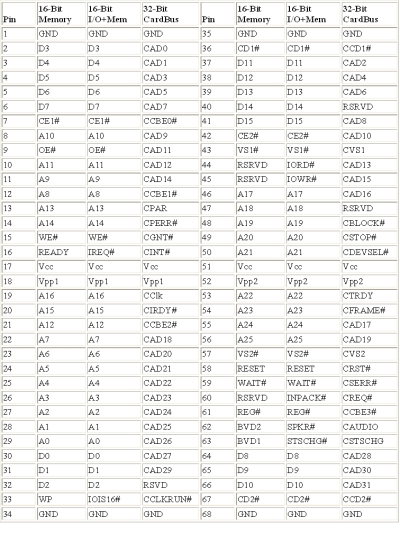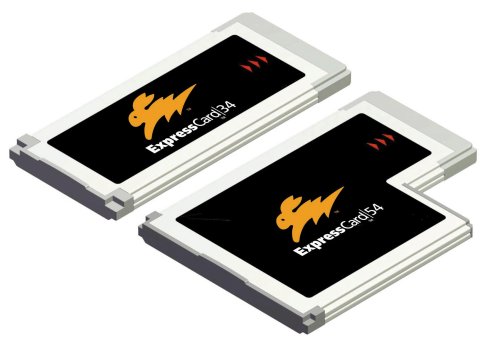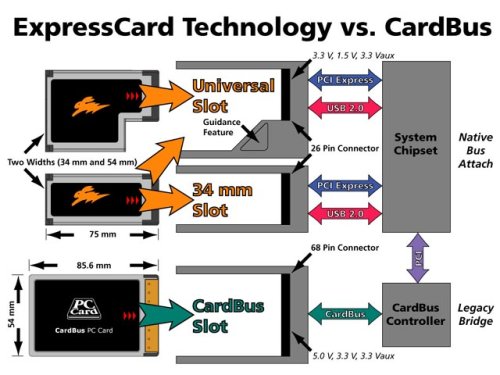Transcend TS16GSSD34E: SSD ExpressCard for those on the Go...
by Dave Robinet on October 25, 2007 12:15 AM EST- Posted in
- Storage
Introduction
As the price/performance ratio of solid state memory continues to improve, so does the list of companies looking to find new uses for devices built around the technology. While some of the implementations of the technology have been obvious (memory for small portable devices like cameras and phones, for example), some of the other uses for solid state memory are only now becoming practical. One such implementation has been realized recently, in the form of ExpressCard-based portable storage.
CardBus - The Legacy
When the CardBus standard was released in 1995, PCI connectivity was the fastest common slot interface in use for machines. CardBus therefore leveraged the existing PC Card standard (85.6mm long, 54.0mm wide) and created a bus to the PCI host. The resulting 68 pin cards which attached to the CardBus slot were subject to physical failure, and always suffered from having to interface their internal circuitry with a fairly complex (and expensive) connector at the end of its interface.

Despite the difficulties in using these connectors, CardBus modules performed a variety of functions for laptop users with relatively good levels of success. As time passed, however, the PCI standard slowly began to fall out of favor compared to USB and PCI-Express. With an eye to improving the lot in life of laptop users who were frequently attaching USB devices to their laptops which stuck out of connectors, as well as answering the increasing call from manufacturers who were concerned about PCI's life expectancy becoming shorter and shorter, the PCMCIA governing body created a new standard: ExpressCard.
ExpressCard - A New Standard

ExpressCard introduces two new packaging formats for laptops, in the form of ExpressCard/34 (34mm wide, 75mm long) and ExpressCard/54 (54mm wide, 75mm long). Both ExpressCard/34 and ExpressCard/54 share the same end connector and performance characteristics, though ExpressCard/54 was designed to allow for more internal space for the card, larger external connectors (if required by the ExpressCard module) as well as greater surface area for heat dissipation.

The ExpressCard standard mandates that each slot have the ability to interface either with the USB host (USB 2.0), or with a dedicated PCI-Express x1 lane. The choice of host interface is made by the attached ExpressCard module itself, and data flows over the appropriate signal pathways in the interface. This allows manufacturers to continue to leverage their existing devices which have already been developed with either USB or PCI-Express in mind, and provide a new packaging for the devices which allows for laptop usage.
Let's take a look at the Transcend ExpressCard SSD and see how it performs today.
As the price/performance ratio of solid state memory continues to improve, so does the list of companies looking to find new uses for devices built around the technology. While some of the implementations of the technology have been obvious (memory for small portable devices like cameras and phones, for example), some of the other uses for solid state memory are only now becoming practical. One such implementation has been realized recently, in the form of ExpressCard-based portable storage.
CardBus - The Legacy
When the CardBus standard was released in 1995, PCI connectivity was the fastest common slot interface in use for machines. CardBus therefore leveraged the existing PC Card standard (85.6mm long, 54.0mm wide) and created a bus to the PCI host. The resulting 68 pin cards which attached to the CardBus slot were subject to physical failure, and always suffered from having to interface their internal circuitry with a fairly complex (and expensive) connector at the end of its interface.

Despite the difficulties in using these connectors, CardBus modules performed a variety of functions for laptop users with relatively good levels of success. As time passed, however, the PCI standard slowly began to fall out of favor compared to USB and PCI-Express. With an eye to improving the lot in life of laptop users who were frequently attaching USB devices to their laptops which stuck out of connectors, as well as answering the increasing call from manufacturers who were concerned about PCI's life expectancy becoming shorter and shorter, the PCMCIA governing body created a new standard: ExpressCard.
ExpressCard - A New Standard

ExpressCard introduces two new packaging formats for laptops, in the form of ExpressCard/34 (34mm wide, 75mm long) and ExpressCard/54 (54mm wide, 75mm long). Both ExpressCard/34 and ExpressCard/54 share the same end connector and performance characteristics, though ExpressCard/54 was designed to allow for more internal space for the card, larger external connectors (if required by the ExpressCard module) as well as greater surface area for heat dissipation.

The ExpressCard standard mandates that each slot have the ability to interface either with the USB host (USB 2.0), or with a dedicated PCI-Express x1 lane. The choice of host interface is made by the attached ExpressCard module itself, and data flows over the appropriate signal pathways in the interface. This allows manufacturers to continue to leverage their existing devices which have already been developed with either USB or PCI-Express in mind, and provide a new packaging for the devices which allows for laptop usage.
Let's take a look at the Transcend ExpressCard SSD and see how it performs today.










10 Comments
View All Comments
strikeback03 - Wednesday, October 31, 2007 - link
Any chance of comparing one of these to a 16GB Corsair FlashVoyager? The Corsair would seem to be more useful unless you always leave the card in a laptop, the Corsair is less expensive, and IIRC quotes higher speeds as well.Also the Extract Archive chart on page 5 - is that really supposed to say 4000 seconds?
JoeBleed - Monday, November 12, 2007 - link
What file system format was used on this drive and the regular USB memory stick?The reason i ask is that i find NTFS under 2k and XP to perform much better than FAT 32.
darkfoon - Saturday, October 27, 2007 - link
On page 5 of the article, at the bottom, the ClipDrive is called the "MSI ClipDrive" however, throughout the rest of the article its been called the MXI ClipDrive.I assume that MSI is a typo, however I've never heard of the MXI brand, so I'm a little confused, I suppose.
ksherman - Thursday, October 25, 2007 - link
This is an ExpressCard SSD, but uses the USB standard to communicate with the computer (even when in the ExCard slot)?! That seems odd, wouldn't the express slot provide faster performance?Dave Robinet - Friday, October 26, 2007 - link
Expresscard uses either USB or SATA as means for communication (page 1 diagram shows that a bit better), so not really - if they'd chosen SATA as the communication method, then it would have better throughput, though.Regardless, the card doesn't approach the maximum transfer rate of the USB bus, so it's a non-issue.
Thanks for reading!
defman - Thursday, October 25, 2007 - link
Some info on how this would perform as a Windows Readyboost device would be nice....dvinnen - Thursday, October 25, 2007 - link
I was thinking it would make for a good ReadyBoost device for the laptop as well. Some info on how it performs there would be nice.Also, is it USB2 that is holding the speed back? If so they really should of done a dual bus, cardbus for when in a laptop, usb for when using the adapter...
Dave Robinet - Friday, October 26, 2007 - link
No, USB isn't holding the speed back at all. You've got loads more room in the USB2 bus for additional performance from the card - it just isn't there.As for ReadyBoost... given the performance of the card, it's doubtful that it would have made an improvement worth spending the additional money on. Good suggestion, though - if we do another Expresscard device in the future, I'll make sure to include it.
Thanks for reading!
-dave
Weiman - Thursday, October 25, 2007 - link
My thoughts exactly.yyrkoon - Thursday, October 25, 2007 - link
One one hand you have the ability to have more storage with potential for less power draw, fast access times, and the ability to just connect it and not have an external power source to worry about.On the other hand, you had a VERY slow product, that barely outperform the average USB v2.0 device, with limited amount of storage potential.
Price does not look terrible though, but I would imagine you could just as easily buy a Corsair 16GB thumb drive for the same price, and not worry about one of these . . . although if this were bootable(did not see it in the article).